
The reredorter or necessarium (the latter being the original term) was a communal latrine found in mediaeval monasteries in Western Europe and later also in some New World monasteries.

The reredorter or necessarium (the latter being the original term) was a communal latrine found in mediaeval monasteries in Western Europe and later also in some New World monasteries.
The word is composed from dorter and the Middle English prefix rere-, coming from Anglo-French rere "backward, behind," from Latin retro; it was coined in the 19th century. The mediaeval term was necessarium (place of necessity). [1]
It was normally attached to the south end or the east side of the monks' dormitory or "dorter" on the east of the main cloister, that is, the end away from the church, [2] with seats arranged on the first floor of the building allowing direct access from the dormitory. Waste fell down chutes or between walls (as far as 7 metres (23 ft)) [3] and was usually carried away by a stream, river or conduit; availability of a suitable stream was often a factor in siting a monastery, [4] and some monasteries have unusual ground plans to enable facilities such as the reredorter to have access to the water. [2]
Sophisticated water engineering was used at Cîteaux Abbey, Roche Abbey and the Carmelite Desierto de Los Leones in Mexico to ensure both that these rooms remained fresh and that the effluent did not pollute water needed for cooking and washing. There appear to have been as many seats as there were monks, separated by screens, [3] and each with a window. [2]
In some monasteries there were two reredorters, one for the monks and one for the lay brothers. The lay brothers’ reredorter was most often to the west of the cloister, attached to their dormitory in a similar way to that of the monks. An example was at Valle Crucis Abbey in Clwyd. [5]

An abbey is a type of monastery used by members of a religious order under the governance of an abbot or abbess. Abbeys provide a complex of buildings and land for religious activities, work, and housing of Christian monks and nuns.

Kirkstall Abbey is a ruined Cistercian monastery in Kirkstall, north-west of Leeds city centre in West Yorkshire, England. It is set in a public park on the north bank of the River Aire. It was founded c. 1152. It was disestablished during the Dissolution of the Monasteries under Henry VIII.

Battle Abbey is a partially ruined Benedictine abbey in Battle, East Sussex, England. The abbey was built on the site of the Battle of Hastings and dedicated to St Martin of Tours. It is a Scheduled Monument.

Netley Abbey is a ruined late medieval monastery in the village of Netley near Southampton in Hampshire, England. The abbey was founded in 1239 as a house for monks of the austere Cistercian order. Despite royal patronage, Netley was never rich, produced no influential scholars nor churchmen, and its nearly 300-year history was quiet. The monks were best known to their neighbours for the generous hospitality they offered to travellers on land and sea.
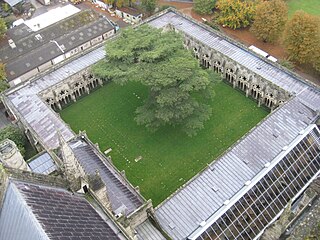
A cloister is a covered walk, open gallery, or open arcade running along the walls of buildings and forming a quadrangle or garth. The attachment of a cloister to a cathedral or church, commonly against a warm southern flank, usually indicates that it is part of a monastic foundation, "forming a continuous and solid architectural barrier... that effectively separates the world of the monks from that of the serfs and workmen, whose lives and works went forward outside and around the cloister."
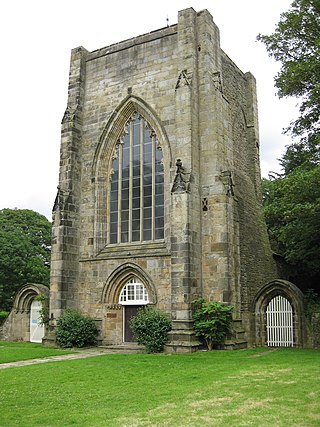
Beauchief Abbey is a medieval monastic house now serving as a parish church in the southern suburbs of Sheffield, England.

A chapter house or chapterhouse is a building or room that is part of a cathedral, monastery or collegiate church in which meetings are held. When attached to a cathedral, the cathedral chapter meets there. In monasteries, the whole community often met there daily for readings and to hear the abbot or senior monks talk. When attached to a collegiate church, the dean, prebendaries and canons of the college meet there. The rooms may also be used for other meetings of various sorts; in medieval times monarchs on tour in their territory would often take them over for their meetings and audiences. Synods, ecclesiastical courts and similar meetings often took place in chapter houses.
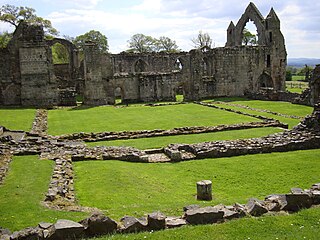
Haughmond Abbey is a ruined, medieval, Augustinian monastery a few miles from Shrewsbury, England. It was probably founded in the early 12th century and was closely associated with the FitzAlan family, who became Earls of Arundel, and some of their wealthier vassals and allies. It was a substantial, successful and wealthy house for most of its four centuries, although evidence of abuses appeared before its dissolution in 1539. The buildings fell into disrepair and the church was largely destroyed, although the remains of some of the domestic buildings remain impressive. The site is now in the care of English Heritage and is open to the public during the summer.
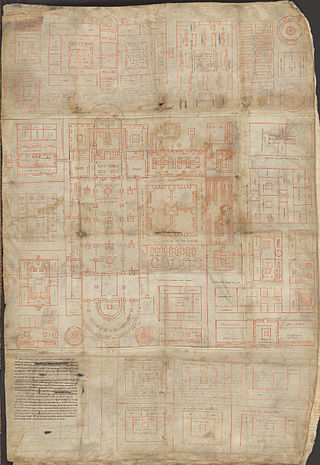
The Plan of Saint Gall is a medieval architectural drawing of a monastic compound dating from 820–830 AD. It depicts an entire Benedictine monastic compound, including churches, houses, stables, kitchens, workshops, brewery, infirmary, and a special house for bloodletting. According to calculations based on the manuscript's tituli the complex was meant to house about 110 monks, 115 lay visitors, and 150 craftmen and agricultural workers. The Plan was never actually built, and was so named because it is dedicated to Gozbert abbot of Saint Gall. The planned church was intended to keep the relics of Saint Gall. The plan was kept at the famous medieval monastery library of the Abbey of St. Gall, the Stiftsbibliothek Sankt Gallen where it remains to this day.

Maulbronn Monastery is a former Cistercian abbey and ecclesiastical state in the Holy Roman Empire located at Maulbronn, Baden-Württemberg. The monastery complex, one of the best-preserved in Europe, was named a UNESCO World Heritage Site in 1993.
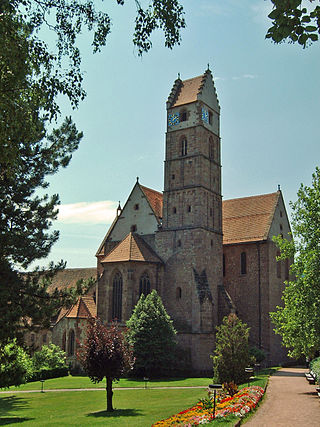
Alpirsbach Abbey is a former Benedictine monastery and later Protestant seminary located at Alpirsbach in Baden-Württemberg, Germany. The monastery was established in the late 11th century and possessed considerable freedoms for an ecclesiastical property at that time, but in the 13th century it became a de facto possession of the Dukes of Teck and then the County of Württemberg. In the 15th century, the monastery enjoyed economic prosperity and was expanded but was dissolved with the conversion of the by-then Duchy of Württemberg to Lutheranism in the 16th century. The monastery became a seminary and boarding school until the 17th century and was physically reduced over the 19th century by land sales and demolition. Over the second half of the 20th century, the monastery was turned into a cultural fixture with annual concerts of Classical music and a museum of its history.

Eberbach Abbey is a former Cistercian monastery in Eltville in the Rheingau, Germany. On account of its Romanesque and early Gothic buildings it is considered one of the most significant architectural heritage sites in Hesse.

Thoronet Abbey is a former Cistercian abbey built in the late twelfth and early thirteenth century, now restored as a museum. It is sited between the towns of Draguignan and Brignoles in the Var Department of Provence, in southeast France. It is one of the three Cistercian abbeys in Provence, along with the Sénanque Abbey and Silvacane, that together are known as "the Three Sisters of Provence."

The Abbey of Fontenay is a former Cistercian abbey located in the commune of Marmagne, near Montbard, in the département of Côte-d'Or in France. It was founded by Saint Bernard of Clairvaux in 1118, and built in the Romanesque style. It is one of the oldest and most complete Cistercian abbeys in Europe, and became a UNESCO World Heritage Site in 1981. Of the original complex comprising church, dormitory, cloister, chapter house, caldarium, refectory, dovecote and forge, all remain intact except the refectory and are well maintained. The Abbey of Fontenay, along with other Cistercian abbeys, forms a connecting link between Romanesque and Gothic architecture.
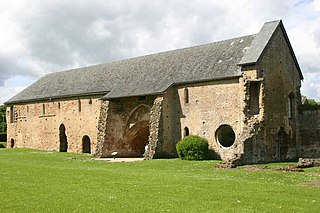
Cleeve Abbey is a medieval monastery located near the village of Washford, in Somerset, England. It is a Grade I listed building and has been scheduled as an ancient monument.

Newbattle Abbey was a Cistercian monastery near the village of Newbattle in Midlothian, Scotland, which subsequently become a stately home and then an educational institution.

Boyle Abbey is a ruined Cistercian friary located in Boyle, County Roscommon, Ireland. It was founded by Saint Malachy in the 12th century.

Valle Crucis Abbey is a Cistercian abbey located in Llantysilio in Denbighshire, Wales. More formally the Abbey Church of the Blessed Virgin Mary, Valle Crucis it is known in Welsh both as Abaty Glyn Egwestl and Abaty Glyn y Groes. The abbey was built in 1201 by Madog ap Gruffydd Maelor, Prince of Powys Fadog. Valle Crucis was dissolved in 1537 during the Dissolution of the Monasteries, and subsequently fell into serious disrepair. The building is now a ruin, though large parts of the original structure still survive. Valle Crucis Abbey is now under the care of Cadw. The abbey received 5,690 visitors in 2018.
Swineshead Abbey was an abbey in Swineshead, Lincolnshire.

A lavatorium, also anglicised as laver and lavatory, was the communal washing area in a monastery, particularly in medieval abbeys and cathedral cloisters. Monks were required to wash before meals; thus the lavatorium was typically adjacent to the refectory.